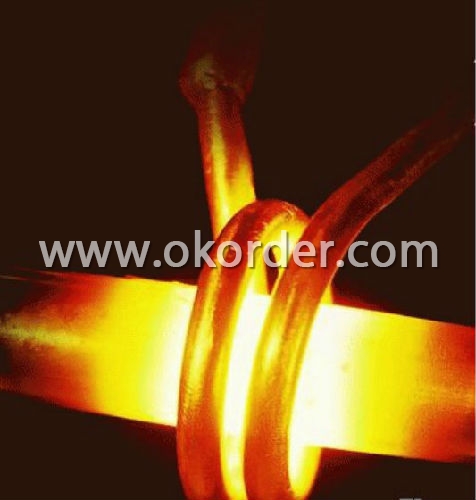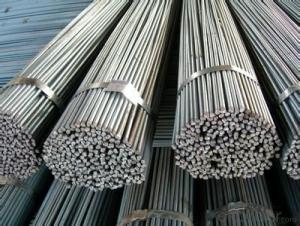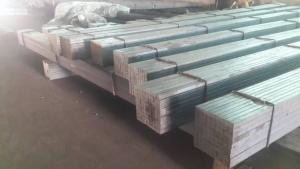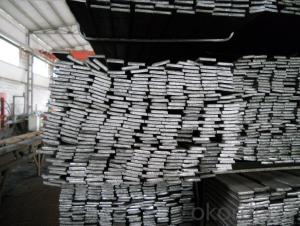Hot Rolled Round Steel Bars Q235
- Loading Port:
- Tianjin
- Payment Terms:
- TT OR LC
- Min Order Qty:
- -
- Supply Capability:
- 200000 m.t./month
OKorder Service Pledge
OKorder Financial Service
You Might Also Like
Specifications of Hot Rolled Round Bar
1. Grade: Q235, SS400, A36, S235JR
2. Diameter: 6mm—150mm
3. Length: As customer’s request, but we usually produce 6m, 9m and 12m
4. Steel Grade: Mild carbon steel
5. Characteristics: Has a good harden ability, high hardness, wear resistance, heat distortion, etc. So it can be used in the production of heavy duty and complex shape mold.
6. Main Markets: Mid East, Southeast Asia, Africa, Oceania, Eastern Asia, Central America and South America, etc.
Usage and Applications of Hot Rolled Round Bar
1. Hot rolled round bar of 6-25mm, or small round is mostly used for straight bundles supply, and used for steel, bolts and various mechanical parts. While the bigger round bar, or more than 25mm hot rolled bar, is mainly for the manufacture of mechanical parts or for seamless steel billet.
2. Besides, we can supply some especial material steel round bar that can be used for main shaft of steamer, hummer shank, with big section and supper force.
Packaging & Delivery of Hot Rolled Round Bar
Packaging Detail: All goods are packed in bundle with steel strips and shipped by break bulk vessel or container (depend on target market and different ports)
Delivery Detail: 45 days
Trade terms: FOB, CFR, CIF
MOQ: 25 tons per specification; we can negotiate the quantity if the specification is normal or we have stock of one specification.
Weight: Theprice invoicing on theoretical weight basis or actual weight basis depends on customer’s request.
Shipment: The shipment of bulk break or container is depends on customer’s request and the situation of the port of destination.
Documents given: Full set of original clean on board bill of lading; Original signed commercial invoice; Original packing list; Policy of insurance; Certificate of origin and what the target market needs.
Production Flow of Hot Rolled Round Bar
We use advanced equipments like Electric Arc Furnace, Ladle Furnace and Vacuum Degasser to produce our products.
The common processes are preheated forging quenching, dual refinement solution process, cooling quenching and isothermal quenching. We use heat treatment for dual refinement solution process. The main measures process is high temperature solution and refinement cycle. High temperature solution can improve the carbide morphology and particle size. The aim is to make the loop refinement ultrafine austenite grains.

Quality Assurance of Hot Rolled Round Bar
1. We will strictly inspect our production that we sold according to the customer’s request.
2. Quality should be in conformity with the specification of the manufacturer. Quantity and packing conditions should be in conformity with the term in the contract.
3. Should the packing found damaged, the buyer has the right to claim to the seller.
- Q:Can a steel square be used for checking the plumbness of poles?
- No, a steel square cannot be used for checking the plumbness of poles. A steel square is primarily used for measuring right angles and making straight cuts, whereas checking plumbness requires a level or plumb bob to determine vertical alignment accurately.
- Q:How do you use a steel square for creating precise tongue and groove joints?
- To use a steel square for creating precise tongue and groove joints, you need to follow a few steps: 1. Measure and mark the thickness of the timber you will be working with. This will help you determine the size of the tongue and groove joints you need to create. 2. Use the steel square to mark the layout of the joint on both the edge and face of the timber. Place the square against the edge of the timber and align it with the marked thickness line. Use a pencil or knife to make the necessary markings. 3. For creating the tongue, position the square against the edge of the timber and align it with the marked layout line. Use the square as a guide to make multiple parallel lines across the width of the timber. These lines will define the width and depth of the tongue. 4. Next, for creating the groove, position the square against the face of the timber and align it with the marked layout line. Use the square to make parallel lines across the width of the timber. These lines will define the width and depth of the groove. 5. Use a chisel or router to remove the waste material for both the tongue and groove. Start by making several cuts along the marked lines for the tongue, and then use a chisel to remove the waste in between the cuts. Repeat the process for the groove, making several cuts along the marked lines and chiseling away the waste. 6. Once the tongue and groove joints are cut, test-fit them together to ensure they align perfectly and create a snug fit. Make any necessary adjustments by further chiseling or trimming until the joints fit precisely. Using a steel square for creating tongue and groove joints helps you maintain accuracy and consistency in the size and alignment of the joints. It provides a reliable guide for marking the layout and ensures that the resulting joints fit together tightly, creating strong and professional-looking connections.
- Q:How do you use a steel square for marking stair newel post angles?
- To use a steel square for marking stair newel post angles, you will need to follow a few steps. First, ensure that you have a steel square, which is a triangular-shaped tool with various measurements marked on its edges. 1. Start by positioning the steel square against the newel post, aligning one edge of the square with the post's surface. Make sure the square is flush against the post and held firmly in place. 2. Next, locate the angle you want to mark on the steel square. The square will have different angle measurements marked on it, such as 45 degrees or 90 degrees. Choose the appropriate angle based on your requirements. 3. Once you have identified the desired angle, take a pencil or marker and trace along the edge of the steel square that corresponds to that angle. This will transfer the angle onto the newel post. 4. Repeat this process for any additional angles you need to mark on the newel post, using the appropriate edges of the steel square. 5. After marking the angles, double-check the accuracy and alignment by using a protractor or other measuring tool. This will help ensure that the newel post is cut and installed correctly. By using a steel square to mark stair newel post angles, you can achieve precise and consistent measurements, resulting in a professional-looking installation. Remember to always double-check your measurements before making any cuts to ensure accuracy.
- Q:How do you use a steel square to lay out a diamond shape?
- To use a steel square to lay out a diamond shape, start by marking a reference line on the material using the long arm of the square. Then, align the short arm of the square with the reference line and mark a point to the left and right of the reference line to create the width of the diamond. Next, rotate the square 45 degrees and align the short arm with the left point previously marked. Mark a point above and below the reference line to determine the height of the diamond. Repeat this step for the right point. Finally, connect the points to form the diamond shape.
- Q:Can a steel square be used for measuring diagonals?
- Yes, a steel square can be used for measuring diagonals. A steel square, also known as a framing square or carpenter's square, is a versatile tool commonly used in woodworking and construction. It has a 90-degree angle and a long blade with measurements marked along its edges. To measure diagonals, you can simply align the square's blade along one side of the object or surface, and then extend the square's other edge diagonally to the opposite corner. The length of the diagonal can then be measured using the markings on the square, providing an accurate measurement.
- Q:Can a steel square be used for checking the squareness of a jointer bed?
- No, a steel square cannot be used for checking the squareness of a jointer bed. While a steel square is a useful tool for checking the squareness of many woodworking projects, it is not specifically designed for checking the squareness of a jointer bed. Jointer beds are typically much longer and wider than the blade of a steel square, so it would be difficult to accurately assess the squareness of the entire bed. To properly check the squareness of a jointer bed, it is recommended to use a straight edge or a precision straightedge specifically designed for this purpose. These tools are longer and wider than a steel square, allowing for a more accurate assessment of the bed’s squareness. Additionally, a precision straightedge often includes measurement markings, which can provide further information about the jointer bed’s alignment. It is important to ensure that jointer beds are properly aligned and square, as this greatly affects the quality and precision of the woodworking projects produced. Therefore, it is best to use the appropriate tools specifically designed for this task to achieve the most accurate results.
- Q:Can a steel square be used for checking the squareness of a router table insert plate?
- Indeed, the squareness of a router table insert plate can be assessed utilizing a steel square. This trusty and precise instrument serves as a dependable means of ascertaining right angles and validating the perpendicularity of the insert plate with respect to the table surface. Placing the steel square against the plate's edges and ensuring a seamless fit devoid of gaps or overlaps enables one to determine whether the plate is flawlessly square or necessitates adjustments.
- Q:Can a steel square be used for marking out through dovetail joints?
- Yes, a steel square can be used for marking out through dovetail joints. A steel square is a versatile and accurate tool that can help ensure precise and square cuts when creating dovetail joints. It can be used to mark out the angles and dimensions of the dovetail joint, providing a guide for cutting and shaping the wood accurately. However, it is important to note that while a steel square can be a useful tool, it is also beneficial to have additional specialized tools, such as dovetail saws and chisels, to achieve the best results when creating dovetail joints.
- Q:How do you use a steel square to determine the length of a stringer?
- To determine the length of a stringer using a steel square, follow these steps: 1. Place the steel square on the edge of the stringer, ensuring that one arm aligns with the edge and the other arm is perpendicular. 2. Slide the square along the stringer until the perpendicular arm reaches the desired length. 3. Mark the stringer at the end of the perpendicular arm. 4. Remove the steel square and measure the distance between the mark and the starting point of the stringer using a tape measure or ruler. This measurement will provide the accurate length of the stringer. It is worth noting that a steel square is a versatile tool utilized for various carpentry and construction tasks. Its L-shaped design enables precise measurements and angles. By employing it correctly, you can guarantee accurate and precise measurements for your stringer or any other woodworking project.
- Q:How do you use a steel square to determine the angle of a roundover cut?
- To use a steel square to determine the angle of a roundover cut, you can place the square against the edge of the material with one leg against the flat surface and the other leg extending over the curved edge. By aligning the square's straight edge parallel to the flat surface, you can then read the angle measurement on the square's scale, which will indicate the angle of the roundover cut.
1. Manufacturer Overview |
|
|---|---|
| Location | |
| Year Established | |
| Annual Output Value | |
| Main Markets | |
| Company Certifications | |
2. Manufacturer Certificates |
|
|---|---|
| a) Certification Name | |
| Range | |
| Reference | |
| Validity Period | |
3. Manufacturer Capability |
|
|---|---|
| a)Trade Capacity | |
| Nearest Port | |
| Export Percentage | |
| No.of Employees in Trade Department | |
| Language Spoken: | |
| b)Factory Information | |
| Factory Size: | |
| No. of Production Lines | |
| Contract Manufacturing | |
| Product Price Range | |
Send your message to us
Hot Rolled Round Steel Bars Q235
- Loading Port:
- Tianjin
- Payment Terms:
- TT OR LC
- Min Order Qty:
- -
- Supply Capability:
- 200000 m.t./month
OKorder Service Pledge
OKorder Financial Service
Similar products
New products
Hot products
Related keywords




























